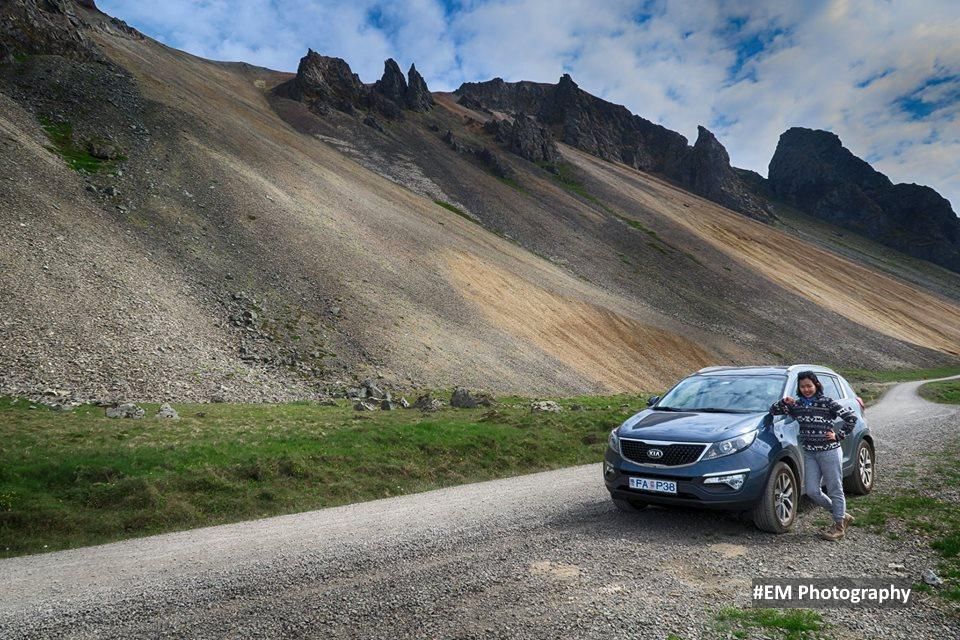- Recently, Iceland has been under the spotlight as one of the favourite travel destinations around the world. Due to its accessible currency to us normal folks, many of our friends and colleagues began to post incredible photos of their trips to Iceland. The photos were so beautiful that it made us so “gian” (aka tempted) to go!
I couldn’t help but whine to Eric that we should be going Iceland for a grand adventure!! So both of us decided to kick into high gear and find the cheapest/value-for-money deals for our Icelandic trip.
1.Air Fare
Airfares are usually one of the biggest cost for every overseas trip. For us, we spent approximately $900 each, in total (Amsterdam > Iceland > Copenhagen). This is seriously cheap as we managed to redeem our Krisflyer miles to Amsterdam on Premium Economy and from Copenhagen back to Singapore on Business Class.
To get to Iceland, there were 3 options that I researched on:
1. Icelandic Air – The national carrier which flies to and fro most parts of Europe and North America. If you happen to include both Europe and North America in your trip, you might want to consider Icelandic Air as they give free 7 days stopover in Iceland.
2. SAS airline – SAS fares are cheap but you would need to pay additional costs for baggage allowances. If you add up the costs, Icelandic Air would be a more value for money choice.
3. Fin Air – Finland national carrier. A common route that Singaporeans like to travel to Iceland passing through Norway using FinAir.
Since Eric and I redeemed our flight to Amsterdam via Singapore Airlines (SQ) and that we needed to get to Copenhagen after travelling in Iceland, we chose Icelandic Air for its flexibility.
The breakdown(Per Person) as follows:
1. Approx $500 for the airport tax + fuel for the SQ flight
2. Approx $400 for Icelandic Air

2. Accommodation
The 2nd biggest cost would be accommodation.
Summer in Iceland is considered as the peak period. Hence, each night’s stay costs us at least $200. The trick to having cheap accommodation is to book early. We used a combination of websites such as Booking.com and AirBnB to get the best value during this peak season.
Tips for Booking.com:
Always book the accomodation with the “Free to Cancel” option. Usually, most listings have this option which allows you to cancel the booking 2 weeks before the travel date. This allows you to be on the look-out for deals and make changes when it comes. We managed to swap our initial booking with other booking deals when a particular hotel threw in a deal. You would need to be diligent and keep going back to the site to refresh the prices and get your best deal.
Tips for AirBnB :
Eric and I have been traveling for awhile now and we realized the true potential of AirBnB. For most of our AirBnB stays, having the washer is a must. We would always choose homes with the “washer” option. It allows us to pack light and be fresh everyday with clean clothes. For our Icelandic trip, we alternate our hotel and AirBnB bookings so that we were be able to wash our clothes every 2 days.
Another advantage of AirBnB is that it allows you to book magical places to stay in. We managed to book one of the highly sought after cottages at Vik’s Black Beach. This place is stunning and it is a must stay!
3. Car Rental
For Car rental, we used “Blue Car Rental” for our road trip. While I couldn’t find any deals or discounts for car rental, I chose this company for the numerous reviews of its service. A close friend of ours actually had an accident during his road trip and the company sent him a replacement car immediately without any delay. Talk about fast and efficient service!
While I do not have experience in trying out other companies nor heard of other car rentals, if you are looking for a fuss free rental, I would recommend Blue Car Rental.

4. SIM-Card
Even though the population of Iceland is numbered at 300,000~ , telecommunication signal is pretty good in most areas and along the Ring Road. There are 3 Telco companies in Iceland, with Siminn being the largest.
If you have friends who previously bought their SIM card in Iceland, take it from them and top it up at the airport. It is much more value for money.
But if you do not have SIM cards like us when we arrived in Iceland, SIM cards are easily available at airport.
There are 2 pre-paid SIM card options that Siminn provides.
| Option 1 | Option 2 | |
| Data | 1GB | 1GB |
| Talk | NA | 100 |
| SMS | NA | 100 |
| Cost | 2000 KR | 2900 KR |
Each of us took the 1GB data plan as I would be using the data for mostly for Facebook and Whatsapp while Eric would be using his for GPS tracking.
To buy the SIM card, head to the store on your right after clearing customs and exiting into the arrival hall. Unfortunately, we couldn’t remember the name as it was 1 a.m. in Iceland when we arrived. The store looks something like our local 7-11 shop and it operates 24 hours. You shouldn’t have any issue finding it. The airport is really small!
5. Cashless Transactions
All you need in Iceland is your credit card. Money changers are rare and hard to find even in Reykjavik. Everything can be paid through your credit card. From petrol stations, restaurants, shops to even using of public toilets. Everything is paid through credit card. Just make sure you remember tto activate your credit card for overseas use before you fly.
A crucial point to note is that the petrol stations in Iceland are mostly un-manned. Meaning that there is usually no one at the station to process payment for you. You would need to get a 4-digit pin from the local bank to be able to use your credit card to pay in the un-manned petrol stations.
For the trip, we used the DBS Altitude card which gave us 2 miles per every dollar we spent. Talk about value!
6. Unpredictable weather
Weather in Iceland is highly unpredictable. It may be cloudy in the morning but within the next hour, the sun is up and vice versa. We would always check the weather in the morning to anticipate how cold it would get and dress appropriately. We found the Icelandic Met Office site particularly useful. It is pretty accurate and we were able to anticipate weather conditions and change our route accordingly.

If you intend to head to Iceland in summer, do know that there is about 23 hours of daylight. However, in winter, expect about 4 hours of daylight. Since we went in the summer, we were able to travel more and fit in impromptu attractions we found along the way.
7. Road conditions
Because of the unpredictable weather, road conditions would change too. A good practice we did was to check the roads we would be heading to or driving along using this official website. Using this website, we spotted a road block on the road we were about to take and made a detour to get to our destination. We were glad we used this website as we found out later that there was a landslide on that road, hence the road closure. Imagine if we didn’t check the road conditions…
8. Packing
Whether you decide to backpack or carry a suitcase for your trip, always pack warm clothing. Weather may turn cold suddenly even in summer, so always have a fleece or ultra light down jacket with you. For us, we had both easily accessible in the car. In the event of cold weather and strong winds, we would suit up and then head out of the car.
Don’t forget to bring along your camera to take beautiful scenic shots too. Handphone cameras don’t do justice to the amazing view you see. So it is better to pack in your trusty camera and get the shot.
Before I forget, don’t worry about the language barrier. Almost everyone we met spoke English, even the seniors.
Enjoy Iceland! 🙂



Comments are closed.